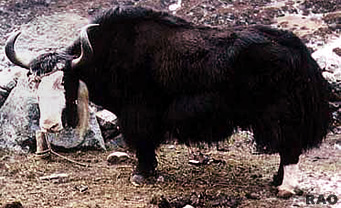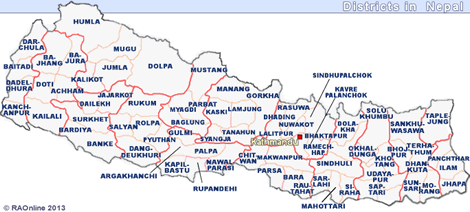 |
Nepal Economy |
 |
Nepal Information |
|
|
 |
|
Taplejung
District: Yak farming on the decline
|

|
The
chief occupation of yak farming in the Himalayan ( high mountain) belt
is gradually going to be extinct for various reasons.
Yak
farmers, who raise yaks in the Himalayan regions, complain that yaks are
dying due to lack of medicine.
They complain that livestock technicians
never visit the yak herds which are located at long distances from Livestock
Development Office and Service Centres.
 |
| Another
hurdle in yak farming is lack of artificial insemination service.
There has been a decline in the breeding of yak due to lack of 'Kiku'
ox found in Himalayan region with the result that farmers are discouraged
on finding that it is difficult to increase the yak herd.
Only
a few Kiku oxen can be found in Papunga Himal region. Kiku ox has become
rare. |
|
Nak
and Dimjo are also vanishing and yak farmers in Nepal possess only Urad
breed of yak. Another important hurdle faced by yak farmers is lack
of grazing land. The
government forest is gradually being handed over to the community as community
forest.
 |
| Therefore, the pasture land which is essential for yak farmers
for grazing the yak round the year is gradually declining with the passing
of every year.
There
are at least 15 yaks in one herd but they require vast area of land for
grazing and shifting them from time to time. |
|
Yak farmers buy yaks from
Tibet Autonomous Region of China. It takes four days' walk from the
border to reach the Tibetan yak herds.
Farmers reach there walking in the
waist-deep snow in autumn season and bring Tibetan yaks bearing great risk
and hardship.
top
|
Yak
farming in crisis
|

|
 |
| Yak
herds need to be moved to 12 places in a year. A user of community forest
can be a member of only one community forest. Therefore, they encounter
problems in moving their herds to different places. If they graze their
yaks in the community forests they are fined. Very few yak farmers are
found to be members of the community forest user groups. |
|
There
is a stiff competition in registering big pasture land as community forest
due to the race for medicinal herbs found there.
Once they are handed over
to the community, they enforce their own rules. As a result of this, yak
farming is in crisis.
top
|
Big
market for Yak products
|

|
 |
| There
is a big market for the cheese produced from the milk of yaks found
in Gola. In addition, 'durkha', 'chhurpi,' 'khuwa' yogurt and whey
are also produced from yak milk. Yaks are also used as a means of transporting
goods in the high mountain belt.
The hair of yak is used to produce
'chhora', 'radhi' and rope.
Shoes, jackets and bags are made
from the hide. The tail of yaks is used for religious purpose and yaks
are also given to daughters as dowry.
Despite all these benefits from
yaks, there is a problem of transporting the yak products, food for yaks
and men. |
|
Although
a few families depend on yaks for their livelihood, technicians hold the
view that yak farming needs to be boosted for the utilisation of high mountain
pasture land and its products. A total of 140 million hectares of land
has been covered by high mountain area in Asia. This land should be utilised
for yak farming to achieve economic upliftment.
In
1993 approximately 60 thousand yaks lived in Nepal supporting the 28 thousand
families of farmers, but the number has declined now.
Yaks die in significant
number due to lack of treatment, labour complications and falling.
| 










